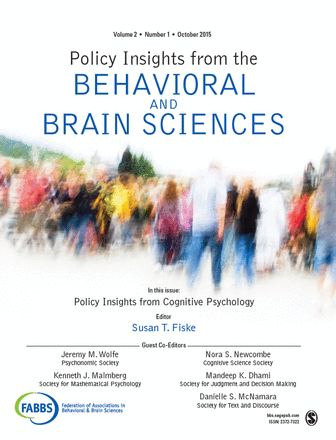Looking at Affirmative Action in a New Light
Affirmative action has sparked heated debates since its beginning. Whether considering African-Americans in higher education or women in math and science, advocates argue that affirmative action helps level an unequal playing field, while opponents sometimes argue that the practice harms minorities by lowering standards and creating tension. But the debates have rarely considered one of the most studied phenomena in social psychology: stereotype threat. That research, while not new, offers a new perspective on the potential benefits of affirmative action – and important cautions about how it should be implemented, according to researchers Toni Schmader and William Hall in their article for Policy Insights from the Behavioral and Brain Sciences, “Stereotype Threat in School and at Work: Putting Science Into Practice.”

Stereotype threat occurs when an individual is afraid of confirming a negative stereotype about a group to which he or she belongs and, in a cruel irony, performs worse because of it. It happens subconsciously. A stereotype – for example, that women are less competent in math than men – subtly causes a person to feel uncertain about her ability, which can raise anxiety, increase blood pressure, and cause the person to be hyper-vigilant about cues suggesting failure. All of these reactions take valuable energy and cognitive resources that make it harder to pay attention and perform well.
This vicious cycle is more likely to happen in situations that bring the stereotype to mind. For example, women are more likely to feel anxious and underperform on math tests in a room full of men, studies show. How the test is presented matters, too. Scores of studies have shown that African-Americans are more prone to stereotype threat when tests of verbal ability are described as indicating intellectual ability, because that description activates the false but pernicious stereotype that African-Americans have lower intellectual capacity than Whites. (In similar experiments with math tests, white students underperform relative to Asian American students, because of a stereotype that Asian-Americans tend to be better at math.) However, when the tests are presented simply as lab tasks, not as indicators of ability, performance is more even across groups, because test-takers are not reminded of the stereotypes.
What is particularly disturbing about these studies, which have been conducted both in labs and in real world settings, is that researchers don’t have to state the stereotypes; they are activated automatically and subconsciously. Another unsettling finding is that people are more likely to be affected by the phenomenon when they strongly identify with the stereotyped group and when they care greatly about the skill or domain being scrutinized. “Ironically, those women and minorities most focused on overcoming the obstacles created by negative stereotypes might also experience stereotype threat most profoundly,” the authors point out. All of these findings suggest that stereotype threat not only decreases performance, but may sabotage many well-intentioned efforts to increase minority representation.
Affirmative action offers a way to redress the insidious process of stereotype threat, Schmader and Hall write. One of the most common criticisms of affirmative action is that it is less fair than purely meritocratic systems. But stereotype threat undermines meritocracy, the researchers point out, citing findings from a meta-analysis that African-American and Latino students’ SAT scores may be reduced by an average of 40 points because of stereotype threat. Affirmative action can help to level the playing field, they argue, and it can also diversify schools and workplaces so that minority status is less salient and so that majority group members can begin to break down stereotypes over time.
The researchers offer a caution, however: affirmative action can be problematic if it appears to lower standards for the minority group, for example by making it “easier” to get into college or get hired. Believing that the bar has lowered can lead members of minority groups to feel that they don’t belong and this can actually worsen stereotype threat, research shows. To avoid this, leaders at the highest levels of their organizations should clearly communicate that all successful candidates are highly qualified and deserving, the authors write. They also recommend that leaders communicate about the impact of stereotype threat so that both majority and minority groups understand how it masks true potential.
Stereotype threat research also suggests other remedies and interventions – including those that create “identity-safe environments,” like making clear statements about valuing diversity, representing diversity in recruitment materials, and eschewing a “colorblind” approach – but it certainly sheds new light on an old but still simmering debate about affirmative action.































































































